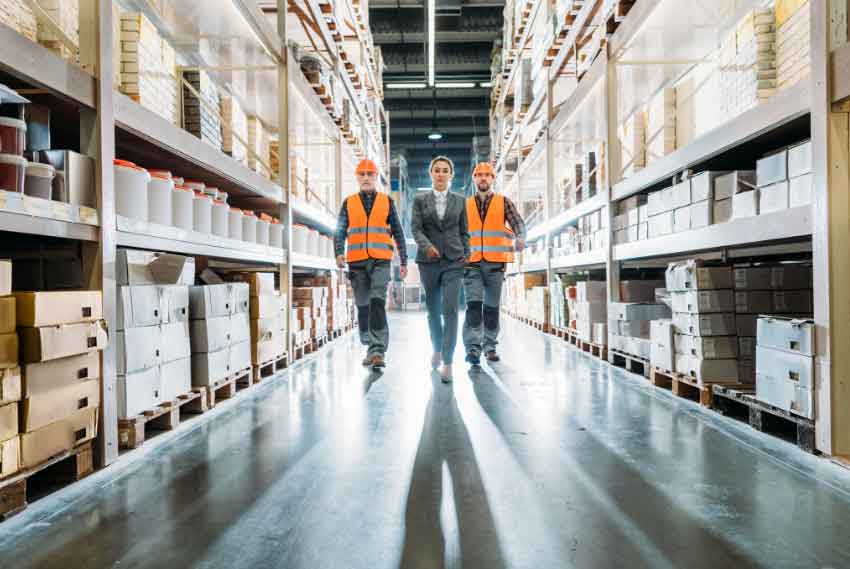Show:
How Software Technology is Revolutionizing Logistics in the eCommerce Industry
In today’s rapidly evolving eCommerce landscape, logistics has become a cornerstone for businesses striving to maintain a competitive edge and meet customer expectations. The integration of advanced software technology has transformed the way logistics are managed, making processes faster, smarter, and more cost-efficient. Below, we explore how these technological innovations are reshaping logistics in the eCommerce industry, providing a clearer path to growth and efficiency.

1. The Role of Software in eCommerce Logistics
eCommerce logistics has become utterly dependent on software technology, which now permeates every nook and cranny of inventory management, order processing, delivery optimization, and customer communication. Manual systems are gradually fading away, replaced by powerful software that streamlines tasks, weeds out errors, and accelerates growth.
Advanced Warehouse Management Systems (WMS)
A key example of software’s impact on logistics is Warehouse Management Systems (WMS). Imagine having real-time visibility into your inventory and warehouse operations – these systems make it possible, relieving you of the hassle of manual tracking and lost space. Through the integration of automation tools, such as Automated Storage and Retrieval Systems (AS/RS), WMS can help businesses reduce labor costs while improving fulfillment speeds.
WMS software is vital for maintaining real-time visibility over stock levels and predicting when restocking is needed. AI-driven WMS systems further enhance these capabilities by optimizing warehouse layouts, improving efficiency, and cutting operational costs.
When you can relate to a genuine example, it all starts to make sense – so here’s one to consider. Amazon, for instance, uses highly sophisticated WMS technology that integrates robotics to speed up order fulfillment, drastically reducing the time from click to delivery.
Predictive Analytics for Inventory Management
The role of predictive analytics in inventory management cannot be overstated. Software platforms now utilize advanced machine learning algorithms to analyze historical data, consumer trends, and market conditions in real-time. This capability has a laser-like focus on demand, letting businesses pinpoint with precision the fine line between too much inventory and too little, dodging the costly mistakes of yesterday.
When businesses use predictive analytics, they can fine-tune their inventory, cut costs, and deliver what customers want, when they want it – a trifecta of benefits that boosts the bottom line.
Data-Driven Insight: Research by McKinsey indicates that companies using predictive analytics in inventory management see an average 20-30% reduction in stock levels, without impacting customer service.

2. Automating Order Fulfillment and Delivery
Efficient order fulfillment is essential for eCommerce businesses, particularly as customer expectations for quick and accurate deliveries continue to rise. Speed and accuracy don’t have to be mutually exclusive. With software automation, you can get the best of both worlds – fast results and pinpoint precision – all while cutting costs.
Process automation powered by robots is rapidly changing the face of business. Logistical tasks, like processing orders and tracking shipments, used to be a major time-suck. But with RPA (Robotic Process Automation), those tasks are quickly becoming a thing of the past. Businesses stand to benefit big time by handing over tasks to automation. With humans out of the loop, they can scale up order processing without sinking more cash into labor or risking errors.
Thanks to their innate ability to sync with eCommerce platforms and Warehouse Management Systems, RPA systems make short work of moving orders from placement to delivery. Automation supercharges a business’s ability to respond to intense periods of demand, helping them meet – and exceed – customer expectations, every time.
Industry Example: Retail giant Walmart employs RPA to manage large-scale order processing, significantly reducing fulfillment times during high-demand periods such as Black Friday.
Last-Mile Delivery Optimization
Last-mile delivery remains one of the most challenging and costly aspects of logistics. Suddenly, efficiency rates have done a 180 – the latest crop of route optimization software deserves the lion’s share of the credit. Picture this: systems actively listening to real-time updates on traffic congestion, projected rain showers, and tight delivery windows, then computing the quickest routes to get drivers from point A to point B in record time.
Faster, more reliable deliveries are the direct result of optimizing last-mile delivery, and customers are cheering the tangible benefits – a win-win all around.
Balanced Perspective: Efficient routes are just the starting point – it’s the physical constraints of the delivery area that can really make or break a business’s last-mile performance. Think poverty-stricken areas with scarce resources or densely populated cities with impossible parking.
3. Reverse Logistics and Returns Management
Perhaps the most telltale sign of an eCommerce operation’s maturity is its return policy. Process them smoothly, and you’ll be rewarded with loyalty and repeat business. Revolutionary software has turned a notoriously slow process on its head, giving companies a fresher, faster approach to reverse logistics.
AI-Driven Returns Management
Artificial intelligence is seriously upgrading returns management – its algorithms pick up on returning customer habits and offload heaps of administrative chores. Data detective work via AI software spells out returns realities. After combing through historical returns, companies can remake flawed products, fine-tune product descriptions, or reroute shipping methods – all aimed at earning back lost sales.
Reverse logistics gets a major boost from AI, which identifies the cheapest way to reclaim or discard returned items and adds it to the bottom line. The automate-or-manual debate is over; returns processing is where technology really proves its worth, saving companies cash and erasing operational headaches.
Real-World Example: Zara, the reigning champ of fashion retail, has tossed AI into the mix to revamp its returns game, catapulting processing speeds and slashing costs – all to the tune of happier customers.

4. Enhancing Customer Communication and Experience
Effective customer communication is now a key differentiator in the eCommerce market. Expectations are sky-high these days, and customers are no exception. They expect to be kept in the loop about their orders, receiving regular updates that assure them their purchase is on its way. Communication that really resonates depends on software tools that enable free-flowing conversations and razor-sharp clarity.
Real-Time Order Tracking and Communication
Software platforms now offer real-time tracking capabilities that keep customers informed about their order status at every stage. With transparency, customer confidence soars, and the avalanche of support requests slows to a trickle, giving your team the room to breathe and blossom.
With AI chatbots handling the lion’s share of customer queries, companies can redirect their human customer service reps to tackle the really sticky issues, such as resolving botched deliveries or orders stuck in an endless delivery loop. What’s the secret to keeping customers happy and human staff calm? Automated systems that can respond to customer needs day and night, of course!
Don’t just read, react! Our call to action is where the real journey begins, so let’s get moving. Customer loyalty relies heavily on the technology you employ. So, take the leap and incorporate real-time tracking software and AI-infused communication tools into your strategy. Customer satisfaction gets a serious lift from these technologies, and customer service teams can finally catch their breath.
5. Sustainability in eCommerce Logistics
Sustainability has become a top priority for both businesses and consumers. Facing intensifying scrutiny over their environmental track record, companies are betting big on software technology to reinvent their logistics. The payoff? A much cleaner, greener business model that actually makes a difference.
Green Logistics and Route Optimization
With optimized routes, the dual benefits are undeniable: speedier delivery times and a smaller ecological impact. Fewer miles traveled mean less fuel burned, a win-win for the planet and the bottom line. Here’s a green benefit that’s hard to argue with: plot out a smarter transportation route and you’ll not only slim down your carbon footprint, but you’ll also spare your business from bloated operational costs.
Eco-Friendly Packaging Solutions
One effective way companies can shift towards eco-friendly practices is by using software to optimize their packaging operations. Cutting-edge algorithms crunch shipment data to pinpoint the most efficient packaging solution, minimizing material usage and reducing waste to a bare minimum. Eco-conscious companies are shifting gears, deploying software to scrutinize their supply chains and get a grip on eco-friendly material usage.
Industry-Specific Insight: According to a report by the World Economic Forum, businesses that invest in sustainable logistics practices can reduce their greenhouse gas emissions by up to 30% while also improving operational efficiency.
6. The Future of Logistics in eCommerce
Fueling eCommerce growth is an unstoppable force; to keep pace, logistics must revolutionize, with tech innovation becoming its lifeline. Imagine a future where logistics runs like a well-oiled machine, thanks to innovative software solutions, AI, and machine learning. This potent combo is poised to catapult the industry toward unprecedented efficiency and customer satisfaction.
The Rise of Autonomous Vehicles and Drones
Autonomous vehicles and drones represent the next frontier in eCommerce logistics. These technologies are already being tested and deployed in select markets, with software playing a pivotal role in route planning, safety management, and delivery optimization.
Objective Perspective: While autonomous technology holds promise, widespread adoption will depend on regulatory approval, infrastructure development, and continued advances in software and hardware capabilities.

Blockchain for Transparent Supply Chains
Imagine a future where shipments are tracked from start to finish with crystal-clear transparency, and goods are protected from nefarious forces with ironclad security – that’s what blockchain tech promises for supply chain management. From farm to table, from factory to doorstep, blockchain tracks it all, creating an unbroken chain of accountability that stops counterfeits in their tracks.
Data-Driven Forecast: Imagine shaving a fifth off your supply chain bills. That’s the promise of blockchain, according to Deloitte’s study. The sweet spot? Amplifying transparency and slashing sluggish practices.
As eCommerce logistics enter a new era of automation, software technology is rewiring the industry from the ground up. No longer bottlenecked by manual processes, businesses can now fine-tune their operations, dispatch products with lightning speed, and forge even stronger bonds with their customers. In a market where every second counts, companies that leverage these innovations will find themselves at a distinct advantage, able to move quickly and stay agile in response to changing circumstances.
Call to Action: To stay ahead in the eCommerce landscape, businesses must invest in the latest software solutions for logistics. Two powerful forces are converging: automation powered by artificial intelligence and environmentally responsible practices. The result? Smoother, more customer-centric operations. With the eCommerce landscape changing at lightning speed, can we really afford to ignore the innovations transforming logistics?
7. Buying New and Used Shipping Containers for eCommerce Logistics
As online retailers scale up, they frequently hit a snag: managing inventory and shipping efficiently. Smart ones turn to shipping containers, which offer room to grow without breaking the bank. Shipping containers, whether brand new or well-worn, possess a ruggedness that allows them to fit seamlessly into established supply chains.
New vs. Used Shipping Containers
Forget frequent replacements and the headaches that come with them – new shipping containers are designed to hold up, saving you time and resources in the long run. A smart shopper can snag a great deal on used containers, and the best part is they’ll hardly sacrifice any durability. To save a pretty penny, companies frequently opt for pre-owned containers – a sensible choice for storage and low-stakes shipping.
Industry Example: Businesses can fine-tune their logistical operations with companies like Premier Shipping Containers, which offer a diverse selection of new and used shipping containers that cater to varying needs and budgets. Scaling up? Shipping containers have got your back – or rather, your cargo – with ample space to accommodate your business’s evolving needs.

 Return to Previous Page
Return to Previous Page








